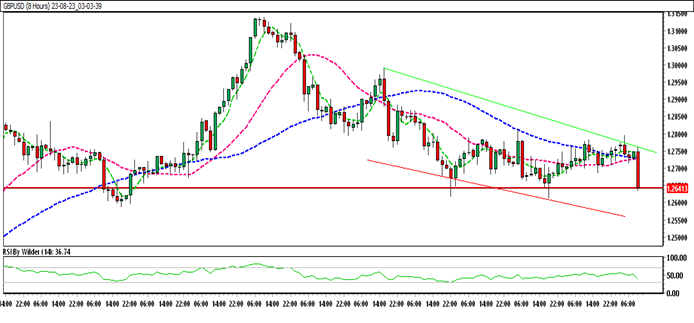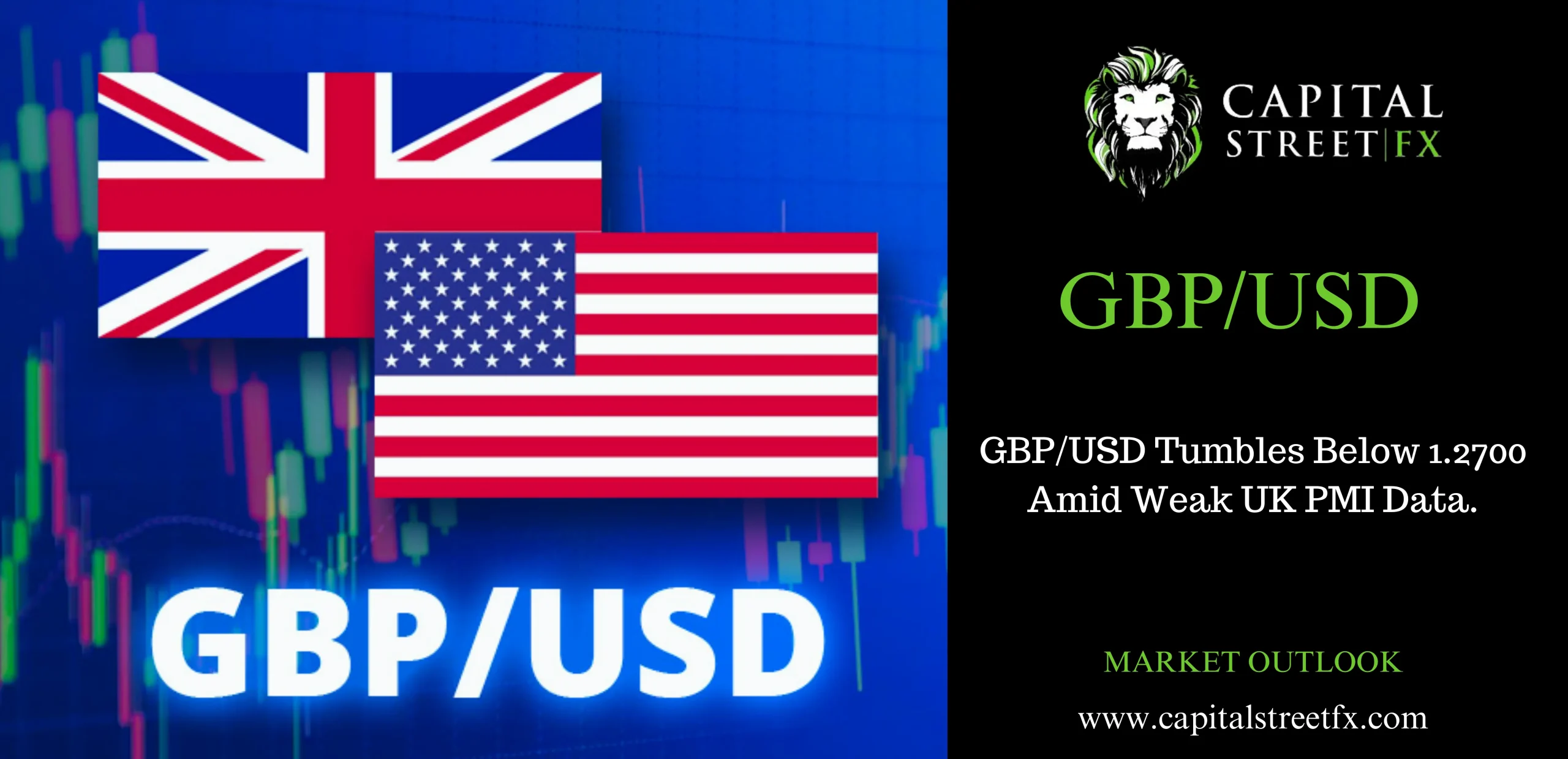GBP/USD Tumbles Below 1.2700 Amid Weak UK PMI Data.
A Closer Look at the Fundamental Landscape
As August unfolds, the economic landscape takes a concerning turn for the UK as the Composite Purchasing Managers’ Index (PMI) dips below the pivotal mark of 50. This slide serves as a clear indication of declining business activity within the private sector. Consequently, this downward trajectory casts its shadow over the GBP/USD currency pair, pushing it below the significant psychological level of 1.2700 during the European trading session on Wednesday. Adding to the unfolding drama, the market’s attention is drawn to the imminent release of the US PMI reports, potentially intensifying the volatility.

Turbulence Across Continents
The currency pair’s journey during the Asian session was characterized by a narrow trading range around the 1.2750 mark. However, as the trading day progressed, GBP/USD embarked on a downward spiral, eventually plummeting to a fresh weekly low beneath the 1.2700 threshold. The immediate concern now centers on whether the pair can muster the strength to reclaim the 1.2700 mark, or if further losses lie ahead.
The UK’s Economic Setback
With the revelation of the UK’s economic data, a pervasive sense of concern reverberates through the financial markets. The Manufacturing PMI, a key indicator reflecting the health of the manufacturing sector, faltered significantly, recording a dismal figure of 42.5 for August. Similarly, the Services PMI, reflecting the services sector’s activity, dipped from 51.5 in July to a worrisome 48.7. This drop across these crucial sectors underscores the economy’s faltering momentum.
Pound Under Pressure
The pound, the UK’s prized currency, faced intense selling pressure in the aftermath of the economic data release. It’s evident that the weak PMI readings have cast a shadow of doubt on the country’s economic prospects. Interestingly, the interest rate swaps, as reported by Reuters, paint a picture of market sentiment. These financial instruments suggest that the markets are only factoring in a less than 50% probability of the Bank of England’s terminal rate reaching the 6% mark. This hesitancy stems from the underwhelming PMI readings, casting doubts on the country’s economic growth potential.
Expert Insights: Inflation and Recession Risks
Chris Williamson, the esteemed Chief Business Economist at S&P Global Market Intelligence, offers his perspective on the PMI surveys. Williamson notes that the initial PMI survey findings for August hint at a potential moderation in inflation in the months ahead. However, he also underscores a concerning revelation – the battle against inflation comes at a substantial cost, manifesting as elevated recession risks. This intricate trade-off between taming inflation and preventing economic decline adds yet another layer of complexity to the current economic landscape.
Navigating GBP/USD: A Technical Exploration
Analyzing the Daily Chart

A closer examination of the daily chart for GBP/USD reveals a market ensnared within a downward channel. The currency pair finds itself positioned beneath all the significant Moving Averages (SMA), indicative of the prevailing bearish sentiment. Adding to this bleak picture, the Relative Strength Index (RSI) firmly resides in the selling zone, underlining the pessimistic outlook. Furthermore, the Stochastic oscillator echoes this sentiment, signaling a negative trend ahead.
Key Levels to Watch
As traders brace for potential developments, the immediate resistance level of note stands at 1.2780. This barrier could prove pivotal if GBP/USD aims to regain its lost ground. Conversely, an immediate support level awaits at 1.2615, serving as a potential floor should further downward pressure mount.
Decoding the GBP/USD Trading Strategy
Navigating the Recent Shifts
Following an impressive ascent, the GBP/USD exchange rate encountered a notable reversal, sparking a downward trajectory. As of now, the currency pair resides within a trading range and has formed a distinctive head and shoulders pattern. The significance of this pattern lies in its potential to signal further declines if the support zone succumbs to selling pressure.
Trade Insights: The Sell Signal
The prevailing market sentiment for GBP/USD leans towards a sell signal. This assessment aligns with the technical and fundamental factors that suggest a challenging path ahead for the currency pair.
Actionable Trade Suggestion
For traders seeking to capitalize on the current dynamics, an entry point at 1.2591 presents itself as a strategic opportunity. With an eye on risk management, a prudent approach involves setting a take-profit target at 1.2491. To mitigate potential losses, a stop-loss order at 1.2672 acts as a safeguard against adverse market movements.
Concluding Thoughts: Navigating Uncertain Waters
In the wake of the weak UK PMI data, the GBP/USD currency pair finds itself grappling with a myriad of challenges. The market sentiment remains cautious as traders ponder the delicate balance between combating inflation and averting the looming specter of recession. As the technical landscape adds another layer of complexity, traders must tread carefully, capitalizing on strategic entry points and diligently managing risk. The evolving dynamics of the GBP/USD relationship continue to command attention, serving as a testament to the intricate dance between economic indicators, market sentiment, and strategic decision-making.
FAQs about the GBP/USD Turmoil
1. What Caused the GBP/USD Plunge?
The plunge of GBP/USD below 1.2700 was triggered by the UK Composite PMI falling below 50, indicating declining business activity.
2. Why Did GBP/USD Decline Further During the European Session?
GBP/USD’s decline below 1.2700 was amplified during the European session due to market concerns about the weak UK PMI data and the impending US PMI reports.
3. What Role Did Weak PMI Readings Play in Pound Selling Pressure?
The weak PMI readings, particularly the Manufacturing and Services PMIs, fueled intense selling pressure on the pound as they pointed to a slowing economy.
4. How Are Interest Rate Swaps Reflecting Market Sentiment?
Interest rate swaps suggest that markets are only pricing in a less than 50% probability of the Bank of England’s terminal rate reaching 6%, given the impact of weak PMI readings.

